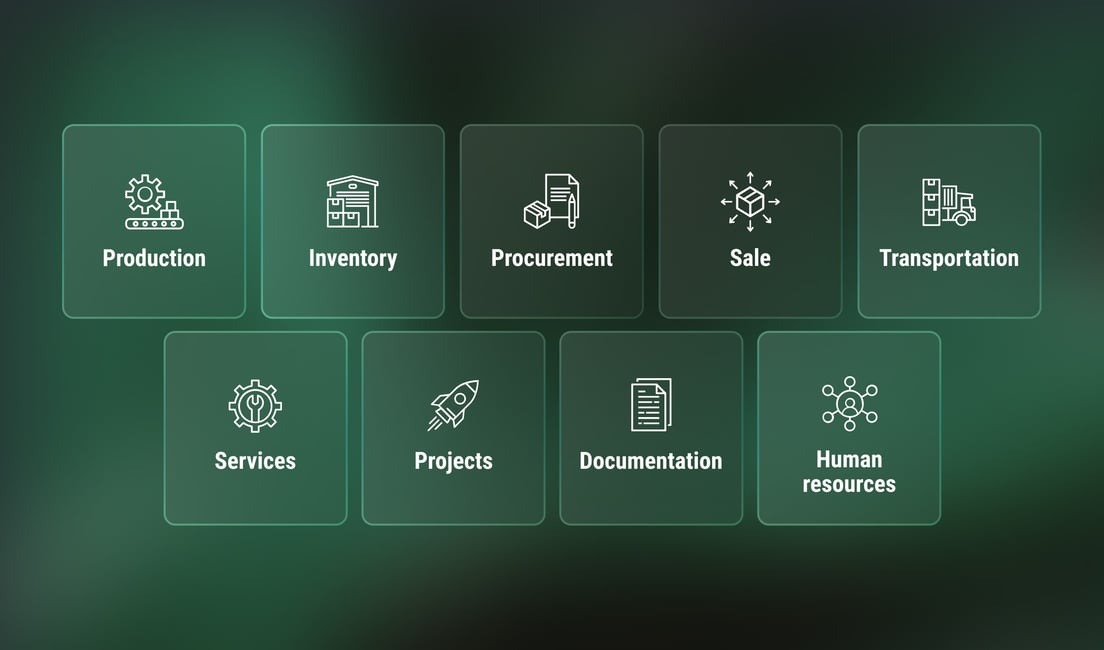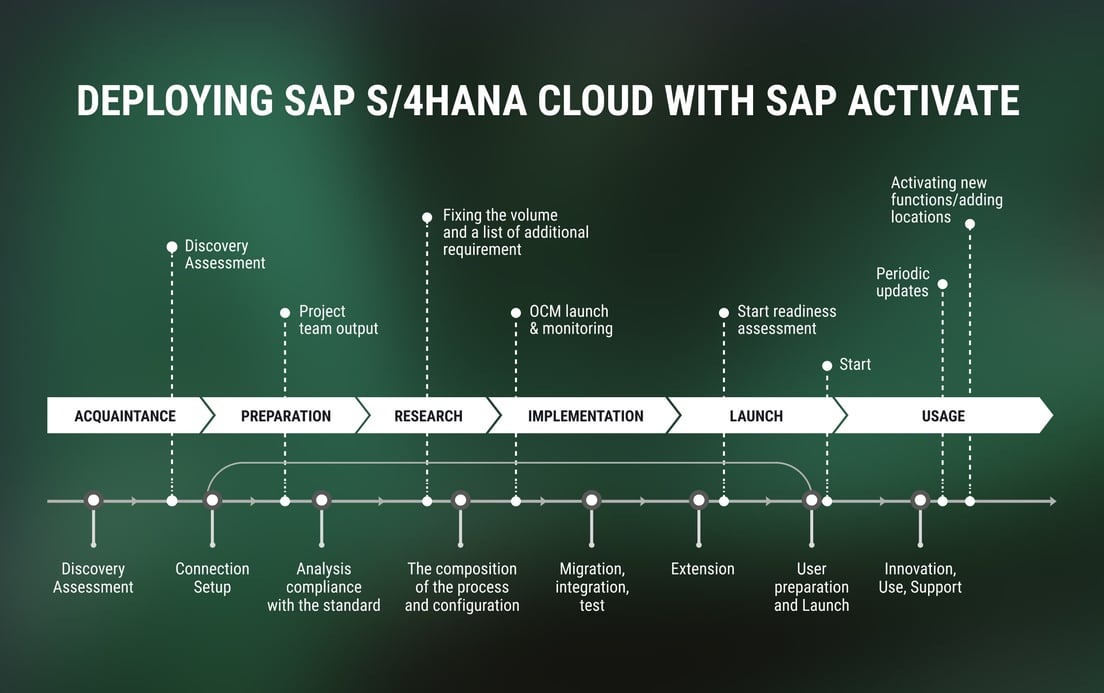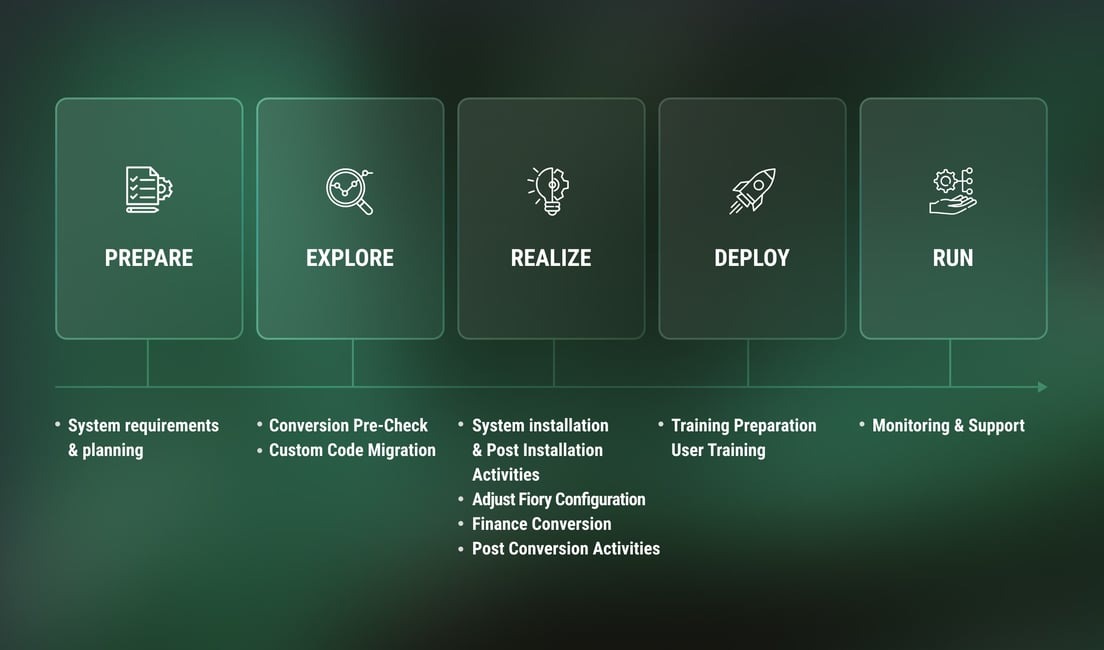In 2027, SAP will no longer support the SAP Business Suite 7, which includes SAP ERP 6.0. We talked with Dzmitry Shupayeu, the LeverX SAP Activate Senior Project Manager, to understand what this means for business, whether it is necessary to migrate to SAP S/4HANA right now, and why those who have never worked with SAP should also think about switching to this ERP system.
Brownfield vs Greenfield: How to Choose an SAP S/4HANA Migration Scenario and Succeed?
By 2027, SAP will discontinue support for SAP Business Suite 7, including its core ERP system, SAP ERP 6.0 (commonly known as SAP ECC). Companies still running SAP ECC or older ERP versions must migrate to SAP S/4HANA — or risk losing access to critical updates, security patches, and new functionality.

Photo: Dzmitry Shupayeu, the LeverX SAP Activate Senior Project Manager
We talked with Dzmitry Shupayeu, the LeverX SAP Activate Senior Project Manager, to understand what this means for businesses and whether it is necessary to migrate to SAP S/4HANA right now. We further explore why those who have never worked with SAP should consider switching to this ERP system.
SAP has confirmed that maintenance for SAP ECC (part of SAP ERP 6.0) will end in 2027. Companies currently using this solution, but not migrating to SAP S/4HANA, will have limited access to new SAP functionality beginning in 2027, and they will not receive further updates.
While there are two years left, it’s time to start thinking about migration now, and here’s why:
- As 2027 approaches, businesses will race to transition to S/4HANA, leading to a shortage of resources, such as experienced consultants, specialists, and cloud infrastructure. The result? Higher service costs and a more complicated process. Starting now helps you avoid the bottleneck and plan your migration without unnecessary stress or expenses.
- Once Business Suite 7 stops receiving security updates and bug fixes, your system’s vulnerability will increase. Migrating to S/4HANA ensures robust data protection, compliance with current standards (like GDPR), and minimized cybersecurity risks.
- SAP S/4HANA processes data in real-time, significantly improving the speed and accuracy of analytics. The sooner you transition, the sooner you’ll leverage these advantages for your business.
- By leveraging in-memory data processing, S/4HANA eliminates delays and optimizes workflows. If your current system slows down operations due to data processing lag or bottlenecks, switching to S/4HANA will resolve these issues.
- S/4HANA supports cloud technologies and integrates seamlessly with innovations like artificial intelligence, machine learning, and the Internet of Things. Migrating now will prepare your IT ecosystem for adopting future technologies without major overhauls.
- The longer you keep working on an outdated system, the more resources are spent on maintaining it. Transitioning to S/4HANA now can reduce long-term costs, increase efficiency, and help you avoid higher migration expenses in the future.
- Early migration allows you to implement changes in stages, ensuring smooth processes and minimizing resistance from employees. You’ll also have ample time to train your team to work effectively with the new system.
If you don't want to work with an outdated system, now is the time to migrate to SAP S/4HANA. This will allow sufficient time to master this intelligent solution.
SAP S/4HANA Benefits for Different Areas
Companies currently working with third-party ERPs should also think about switching to SAP S/4HANA, as this will help optimize and automate the management of all business areas of the company:
Inventory
No more stockpiles gathering dust or empty shelves causing delays. Real-time tracking and analytics help manage inventory more accurately, cutting storage costs and making sure everything you need is on hand — when you need it.
Procurement
From sourcing to payment, procurement becomes faster and clearer. Built-in analytics evaluate supplier performance, helping you make informed decisions and build strong, reliable partnerships.
Sales and distribution processes
SAP S/4HANA automates order processing, customer engagement, and demand forecasting. This speeds up your sales cycle, improves customer satisfaction, and leads to better margins.
Logistics planning
Plan and adjust transportation routes with ease. The system helps you lower delivery costs and ensure goods arrive on time, keeping your supply chain running smoothly.
Service
A well-organized service department means quick responses and consistent quality. Automation takes care of routine tasks; your team focuses on keeping customers happy and engaged.
Project management
With SAP S/4HANA, projects are easier to manage. You gain visibility into deadlines, resources, and budgets — all in one place. This helps you avoid surprises and deliver results on time.
Document management
The system handles everyday documentation tasks and supports compliance standards. You can store, retrieve, and manage files more easily, cutting down on administrative load.
HR management
From hiring and onboarding to training and performance reviews, SAP S/4HANA supports your HR team at every step. Automating the basics lets you focus on building a motivated and productive workforce.
Integrating all these processes into a single platform empowers your company to work faster, more efficiently, and at lower costs. This frees your employees to focus on strategic planning and making more impactful decisions.

SAP ERP 6.0 and SAP S/4HANA: What’s the Difference?
The SAP Business Suite that includes SAP ERP was launched in the early 2000s, and ever since it has successfully improved process automation, solution integration, and financial and material accounting. However, with advanced technology, its functions are becoming outdated, making it difficult to implement new business models.
SAP S/4HANA is a new generation ERP system that includes the most advanced technologies:
- Cloud solutions
- Mobility
- Predictive analytics
- In-Memory
- Sensors
- UX, etc.
Let’s compare these two systems to more clearly understand their differences.
| Feature/characteristic |
SAP ERP 6.0 |
SAP S/4HANA |
| Solution type | On-premise system hosted on enterprise servers | Flexible deployment: on-premise, public, or private cloud |
| Deployment | Traditional, on physical servers | Flexible options via RISE with SAP, cloud, or on-premise |
| AI capabilities | Limited AI integration | Seamless AI integration for predictive analytics and process optimization |
| Predictive analytics | Limited predictive capabilities | Built-in predictive analytics for inventory, production, and maintenance planning |
| Data processing speed | Relies on traditional databases | In-memory HANA database for real-time data processing |
| Mobility | Limited mobile functionality | Intuitive Fiori UI for mobile access across all users |
| Internet of Things (IoT) support | Limited IoT support | Full IoT integration for real-time data from sensors and process optimization |
| Security | Standard security methods | Advanced security, including encryption, multi-factor authentication, and access control |
| Industry solutions | General-purpose solutions applicable across industries | Specialized industry solutions for faster implementation and process optimization in specific sectors (e.g., manufacturing, logistics, healthcare) |
| Flexibility and scalability | Limited scalability options | Highly flexible, scalable, and adaptable to business growth needs |
| Cloud integration | Limited cloud integration | Full integration with cloud solutions for enhanced flexibility and data accessibility |
“SAP S/4HANA is the digital core of your enterprise. With it, you can conduct transactions and receive analytics within one system. Its flexibility allows the system to integrate with cloud solutions and IoT sensors, and built-in modeling and predictive capabilities help make fast and intelligent decisions avoiding risks in the future.”
Increase Your Income by 20% Using SAP S/4HANA
How to Start SAP S/4HANA Migration
There is no specific timeline for the start of migration, but it is better to do this before the end of SAP ERP maintenance in 2027. Migration to SAP S/4HANA typically takes 9 to 12 months. However, according to Gartner, this period can be longer, especially during the implementation of key steps.
Start the migration process as early as possible to give yourself enough time to master the new system and its capabilities. This will help you save money, as implementation costs could rise before 2027.
So, Brownfield or Greenfield? Or Perhaps Hybrid?
When it comes to the main SAP S/4HANA migration approaches, there are two: Brownfield and Greenfield. However, organizations seeking a middle path can also consider Bluefield, a hybrid approach which combines aspects of both. We’ll touch on this approach later.
A Brownfield approach means transforming an existing SAP ERP system to SAP S/4HANA. Greenfield stands for installing SAP S/4HANA from scratch.
“Brownfield is a good option for enterprises that have already deployed the SAP ERP system. As for the Greenfield approach, it's not that simple. It’s possible to implement SAP S/4HANA from scratch both in businesses that have never used SAP solutions before and in enterprises that have already worked with SAP ERP. The second option is suitable for companies that have a complex SAP system with a lot of third-party system integrations. In this case, the enterprise also has the opportunity to revise, unify, and simplify business processes by using Best Practices in Greenfield implementation. Brownfield is also not suitable for companies that cannot afford network downtime, which is possible in this migration approach. Moreover, a large number of existing custom developments can become an obstacle in this migration approach."

Let’s take a closer look at each approach.
Greenfield Approach: Implementation From Scratch
A Greenfield approach involves process restructuring and comprehensive simplification through the implementation of SAP best practices. The customer's systems are completely reinstalled and reconfigured under the project.
Greenfield migration is suitable for both new SAP customers and those who have already used its solutions in their business, especially companies with a complicated ERP system. SAP S/4HANA implementation from scratch eliminates unnecessary decisions and data, making business management processes more flexible and simple.
Key features
- From day one, leverage the full potential of cutting-edge technologies like AI, machine learning, and SAP Fiori.
- Choose between on-premise or cloud (Public/Private Cloud) solutions to suit your business needs.
Recommended when
- Your current ERP system is unsatisfactory, and you aim to completely revamp your IT landscape.
- Your business requires the implementation of entirely new processes and operational models.
- You want to unlock the full capabilities of SAP S/4HANA with minimal restrictions.
Considerations
- A full overhaul of your processes is required, which can be time-intensive.
- Implementing and scaling new processes may take longer than anticipated.
- Additional systems may be necessary to ensure business continuity during the transition.
Greenfield approach stages and implementation timeline
“A key benefit of this strategy is the opportunity to deploy the system immediately on the cloud using RISE with SAP S/4HANA Cloud, private edition, which greatly saves project implementation time and, in the long run, maintenance costs."

Greenfield: example of a customer’s production enterprise
The customer understood that its enterprise management and accounting solutions did not meet the current business needs and did not solve many of its problems, among which were:
- Lack of process details
- Lack of an automated control system
- Increased manual operations, including data collection and processing
- Poor materials management
- Human errors
“LeverX chose SAP S/4HANA to address these challenges. Our experts have already completed the system implementation and localization at the customer's enterprise and are now preparing a template for its distribution for the company’s branches.”
Under the project, our experts implemented the SAP Financial Accounting module into the customer's system to keep accounting functions within the company, nationally and internationally, including tax accounting. The LeverX experts ensured localization of tax accounting based on SAP S/4HANA, according to the legislation of the country where the customer is headquartered, and helped to create a system of unified financial reporting for all the company’s branches.
LeverX also implemented SAP Plant Maintenance, which is a platform for maintenance management. This helped move from on-demand repairs to preventive equipment maintenance. Integration with the SAP Sales and Distribution and SAP Materials Management modules ensures the continuous flow of information on any material movements and on-time orders.
Greenfield approach in action: how Makro reinvented its business processes with SAP S/4HANA
When Uzbekistan’s largest retail chain, Makro, embarked on a massive IT landscape transformation, it became clear that a standard approach wouldn’t suffice. The company required a complete overhaul of its processes to sustain rapid growth, comply with international standards, and maintain market leadership. The solution was the Greenfield approach — building a system from scratch with SAP S/4HANA.
Initially, Makro operated on SAP ERP, but years of system customization had created limitations that slowed the adoption of new technologies. Instead of undergoing a complex migration of legacy data, the company chose to completely redesign its processes, laying the groundwork for scalability, automation, and transparency.
Implementation highlights
Analysis and design. The LeverX team conducted a comprehensive audit of Makro’s business processes, identifying key areas for improvement, including:
- Accounting in compliance with IFRS standards
- Logistics optimization
- Inventory management
- Document workflow automation
System Relaunch. The Greenfield approach enabled the creation of a new management system that unified financial, logistics, and retail operations into a single platform. Key implementations included:
- Three accounting registers (IFRS, NSBU, and tax accounting)
- Automated currency rate updates for price calculations
- A transparent cost and profit structure across all stores
Integration and automation. The system was integrated with platforms like faktura.uz and the Uzbekistan Inspection Service. This streamlined invoice processing, reduced document handling time by 40%, and boosted warehouse efficiency by 20%.
Results
- Financial transparency: Reporting accuracy improved by 30%.
- Speed and efficiency: Order processing became faster, enhancing customer experience.
- Scalability: The new platform enabled rapid business growth.
Brownfield Approach: Software Upgrade
The Brownfield approach converts an existing SAP ERP system to SAP S/4HANA. It keeps all current processes, data, customizations, and add-ons, transferring them to the new environment.
Brownfield migration works well for businesses that recently implemented SAP based on standard practices, or for those aiming for a quick switch to SAP S/4HANA without disrupting existing operations.
Key features
- Retains existing data, configurations, and business processes.
- Step-by-step adoption of innovations like SAP Fiori and machine learning.
- Available only for on-premise deployments.
Recommended when
- Your current SAP infrastructure is satisfactory, and you want to keep it.
- You need a fast migration with minimal disruption.
- Your company prefers to avoid major process changes and stick with familiar systems.
Considerations
- Your business capabilities might be limited at the early stage of migration.
- Custom code might need simplification or adaptation for SAP S/4HANA compatibility.
- Data migration may require system downtime.
- The system must be converted on-premise before transitioning to SAP S/4HANA Cloud.
The Brownfield approach: stages and implementation timeline
“This approach doesn’t allow migrating the system directly to the Hyperscale cloud since the system must be deployed on-premises before moving to the SAP S/4HANA Cloud.”

The Brownfield approach focuses on converting your existing SAP ERP system into SAP S/4HANA without rebuilding everything from scratch. The project starts with a system assessment and preparation activities to ensure compatibility. Then comes the technical conversion, followed by testing and post-migration support.
While the process is structured, it’s usually faster than a full Greenfield implementation since it relies heavily on existing configurations and historical data. This makes it a popular choice for companies looking to modernize with fewer disruptions and within shorter timeframes.
Below are the general benefits and limitations of choosing the Brownfield path:
Advantages
- Faster implementation compared to full reinstallation.
- Preserves legacy data and custom developments.
- Reduces costs related to user retraining and change management.
- Minimizes risk by keeping familiar business processes in place.
Disadvantages
- Limited ability to simplify or improve outdated business processes.
- Less access to SAP best practices.
- System complexity may increase due to old customizations.
- Lower use of SAP S/4HANA's full capabilities compared to a fresh implementation.
Brownfield approach in action: example of a large international retailer
The LeverX team of specialists implemented two projects as part of the customer's Brownfield migration.
The first project includes the following tasks:
- Data migration
- SAP S/4HANA setup
- Transferring Cash Management Liquidity Planner functionality from SAP ECC to SAP S/4HANA.
Cash Management Liquidity Planner helps track the organization’s cash flows. The system allows all calculations to be carried out in real time, which accelerates decision-making on the distribution of cash flows. They can now be tracked and analyzed, thanks to cash flow statements in SAP Fiori.
The LeverX team also contributed to the refinement of reporting related to procurement under the EU requirements.
The second project, which is currently being implemented by the company's experts, is the setup of the SAP Recipe Development module, a solution used for product, formula, recipe, and label development.
The task of the LeverX team was to create and ensure the functioning of an end-to-end chain of business processes, from the development, agreement, and approval of the recipe to its implementation (production).
Boosting performance with SAP S/4HANA and SAP BTP using the Brownfield method
When a company faced challenges in maintaining and optimizing its SAP S/4HANA system, it decided to enhance its performance to reduce update disruptions and streamline internal business processes.
Previously developed extensions and custom applications did not adhere to the "Clean Core" principle, leading to higher update costs and complicated system maintenance. This technical debt caused issues like poor code quality and difficulties transitioning to new S/4HANA versions.
We adopted the Brownfield approach, focusing on optimizing the existing system rather than replacing it entirely. The goal was to preserve customized elements while minimizing changes during migration.
Implementation highlights
- Infrastructure analysis: Our experts assessed the current SAP architecture and custom ABAP applications to identify areas for improvement.
- SAP BTP integration: Using SAP Business Technology Platform (BTP), we modernized ABAP programs to reduce customization and boost performance.
- Low-Risk transformation: Modernization retained existing data and improved code quality, avoiding major disruptions and lowering maintenance costs.
- Training and workshops: Employees were trained on SAP BTP capabilities, helping them understand how the platform supports transformation.
Results
- Reduced maintenance costs: Thanks to optimized code.
- Increased Flexibility and Scalability: SAP BTP's cloud architecture enabled quick adaptation to change.
- Minimized Downtime: Thorough preparation ensured seamless updates.
The Best of Both Worlds: Bluefield Approach
The Bluefield approach blends elements of both Greenfield and Brownfield methodologies, enabling companies to completely overhaul processes while preserving specific data or infrastructure. This hybrid strategy provides greater flexibility, reducing risks and costs for businesses.
Key features
- Selective system updates: Choose which data and processes to migrate or rebuild.
- Quick innovation adoption: Rapidly integrate AI, IoT, and predictive analytics.
- Flexible deployment: Suitable for both on-premise and cloud setups.
Recommended when
- You want to implement new SAP S/4HANA features while retaining some legacy processes.
- You need a balance between fast migration and significant improvements.
- You’re seeking an optimal way to adopt new technologies with minimal risks.
Considerations
- The migration process can be more complex, as integrations between new and existing system components must be configured.
- Gradual innovation implementation may be required, which contributes to extending the time needed for full adaptation.
Bluefield approach in action: Eurasia Group Kazakhstan's Bluefield migration to SAP S/4HANA
When Eurasia Group Kazakhstan, the national dealer for John Deere in Kazakhstan and Kyrgyzstan, faced limitations with their outdated SAP ECC system, they decided to transition to the modern SAP S/4HANA platform. The company sought a balance between preserving proven processes and adopting innovative capabilities, making the Bluefield approach the perfect solution.
Why Bluefield
This method combined advantages of both the Greenfield and Brownfield approaches, resulting in the following:
- Retained critical legacy processes and data, ensuring uninterrupted supply chain and after-sales operations.
- Implemented new SAP S/4HANA features, like built-in analytics, automated procurement, and inventory management.
- Minimized risks and accelerated migration by, selectively upgrading modules.
Implementation highlights
LeverX experts migrated core business processes to the new platform within 8.5 months. The preparation phase included:
- Data cleansing and harmonization
- Business “as-is” and “to-be” processes
- Employee training to work with the new system
These steps helped to ensure a smooth transition with minimal impact on current operations.
Results
- Enhanced sales, procurement, and customer service processes
- Reduced system maintenance costs
- Secured updates post-2027, maintaining market competitiveness
“With the transition to SAP S/4HANA, Eurasia Group Kazakhstan will increase business process efficiency through SAP best practices and accumulated global experience. The company will reduce the financial costs of using the system and will be able to switch to modern and convenient Fiori interfaces, which will help corporate users to organize their work in a new way,”
— commented Evgeny Teremov, Managing Director of SAP Kazakhstan.
Automotive Manufacturer’s SAP S/4HANA migration via Bluefield approach
A leading automotive manufacturer aimed to streamline complex production processes, integrate fragmented IT systems, and shift from manual planning to automated solutions.
Solution
LeverX adopted the Bluefield approach, enabling the manufacturer to:
- Retain valuable data and developments (such as already configured processes and integrations).
- Consolidate fragmented IT infrastructure in a single project.
- Modernize key business areas without halting production.
Instead of a complete overhaul or full migration, the Bluefield approach provided the flexibility to adapt: modernizing what’s necessary while preserving proven solutions.
Implementation highlights
- Business process analysis: Over the course of two weeks, our team analyzed key operations: production, logistics, finance, and planning. We identified bottlenecks and areas for automation.
- MES and SAP S/4HANA integration: The outdated GM GEPICS system was integrated with the new ERP. Data centralization helped eliminate duplication and improve accuracy.
- Warehouse and logistics modernization: The implementation of SAP EWM automated inventory management and order processing. RF terminals and the address storage system made warehouse operations transparent and efficient.
- Financial optimization: Using SAP FICO, we automated bank statement analysis and cost calculations, accelerating the closing of financial periods.
- Digital marketing: SAP CRM and Marketing Cloud helped create personalized sales strategies and increase market share.
Results
- 3% reduction in inventory storage time
- 4% faster production cycle
- 10% fewer losses from component shortages
- 5% improvement in delivery accuracy
- 15% higher employee engagement
Choosing the Right Migration Approach
Your migration strategy should align with your ERP system’s current state, business goals, and readiness for change.
| Parameter | Greenfield | Brownfield | Bluefield |
| Migration type | From scratch | System conversion | Hybrid approach |
| Deployment speed | Slow | Fast | Medium |
| Innovation access | Immediate | Gradual | Phased |
| Deployment flexibility | On-premise/cloud | On-premise only | On-premise/cloud |
| Process changes | Full redesign | Minimal changes | Partial redesign |
| Risks and complexity | Lengthy process | Downtime during migration | Integration complexity |
Explore our end-to-end SAP S/4HANA migration services to achieve seamless and effective transformation.
How to Successfully Move to SAP S/4HANA?
Our expert Dzmitry Shupayeu gave some tips on how to successfully migrate to SAP S/4HANA, regardless of the chosen migration approach:
- Adhere to the project scope. Any changes can affect the project schedule, effort, and cost.
- Remain pragmatic. Set up processes in accordance with the system standard. functionality to simplify the update and expansion process.
- Don’t delay decision-making. Fast solutions mean fast project development.
- Attract interested parties. For example, department heads, employees, and key customers.
- Be actively engaged in the project. A deep understanding of your business area will help you customize the system in accordance with all your requirements.
- Prepare data in advance. This will help avoid issues and delays in project implementation.
- Focus on testing. Proper quality control is the key to successful system operation.
However, none of these tips will work without a reliable team to help you implement your migration project.
Ensure the Success of Your Migration Project with LeverX
LeverX is a leading global SAP integrator that specializes in implementing and migrating SAP solutions, including SAP S/4HANA. With over 20 years of experience, we’ve successfully partnered with businesses worldwide, delivering SAP solutions tailored to organizations of all sizes and industries.
The LeverX team consists of 1,800 highly qualified experts whose experience and knowledge allow them to handle any tasks, from system analysis to its implementation and post-launch support.
What we offer:
- Analysis and consulting: We take the time to understand your business and develop a migration strategy perfectly suited to your needs. Our experts conduct a detailed assessment of your current infrastructure to recommend the best solutions.
- Selection of a migration strategy: When it comes to migrating your systems, we offer a range of approaches — Greenfield, Brownfield, or even Bluefield — to ensure the solution aligns perfectly with your business needs.
- Deployment and integration: We guarantee a seamless transition to SAP S/4HANA, handling everything from configuration and data migration to integration with other enterprise systems. The outcome is a seamless, low-risk upgrade where everything functions as it should.
- Optimization and ongoing support: Our job doesn’t end once the system is live. We provide ongoing support, optimize processes, boost performance, and adapt functionality as your business evolves.
If the time for the digital transformation of your business has come, contact LeverX experts to explore how we can help.
How useful was this article?
Thanks for your feedback!

-min-Jul-12-2022-09-46-40-14-AM.jpg)

